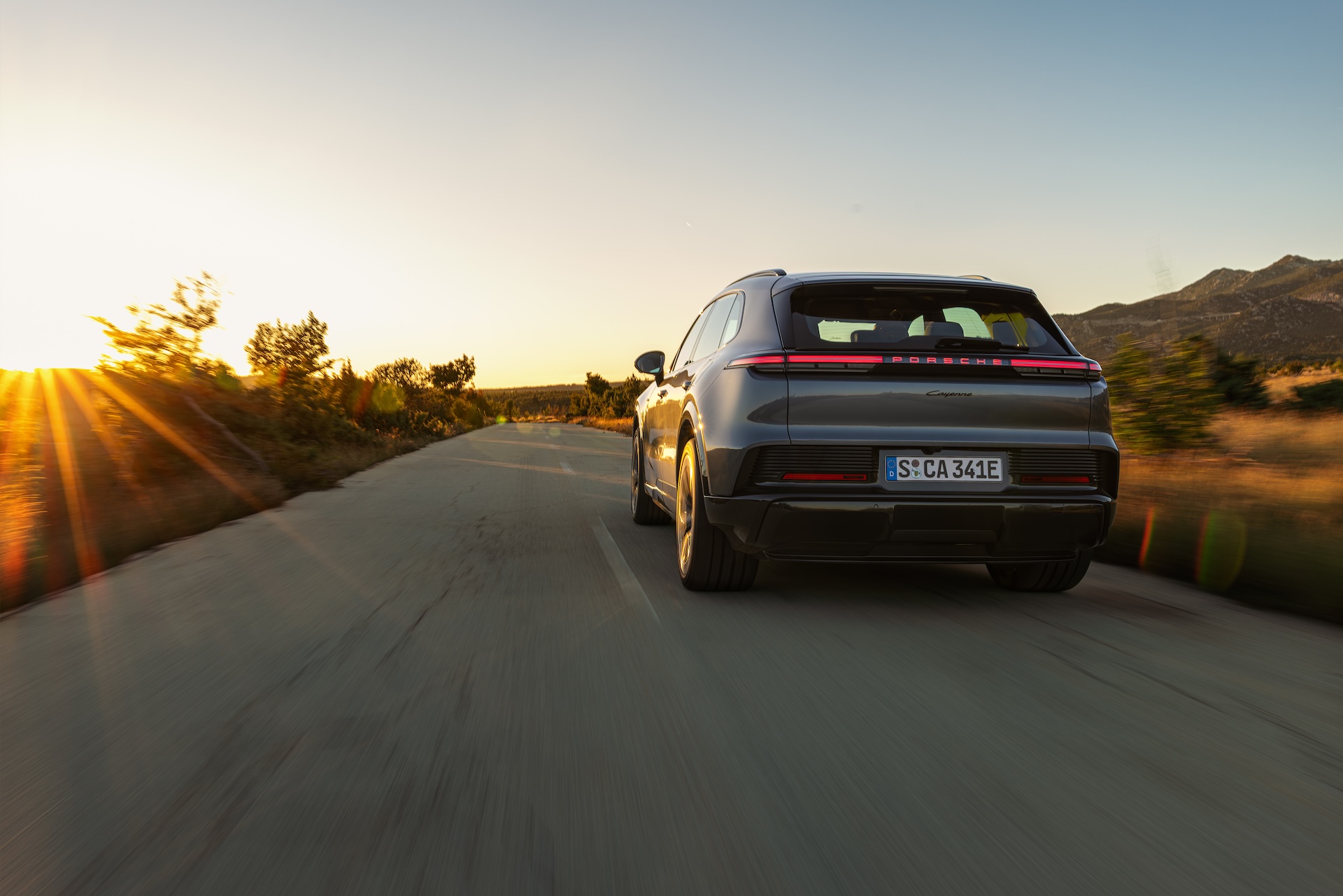In detail: the electric Porsche Cayenne and Cayenne Turbo
Premium electric SUVs
The introduction of these models marks an important moment: the Porsche Cayenne was previously at the heart of Porsche’s global growth, and now the model takes on a new role at a time when electric driving is becoming increasingly important. With two powerful powertrains, a high level of recuperation and a battery pack that offers a generous range according to WLTP measurements, Porsche is positioning the new Cayenne directly in the segment of premium electric SUVs.
A new era for the Porsche Cayenne
When Porsche presented the first generation Cayenne in 2002, it was a bold step toward a market that until then had been dominated by large SUVs with a more utilitarian slant. The Cayenne combined space and versatility with sporty characteristics that until then had been primarily associated with the brand’s coupe and sports car models. The introduction of the electric Cayenne in 2026 builds on that history, but places the car in a completely new context.
Around a third of Porsche models worldwide are now electrified, bringing the new Cayenne into a market where electric driving has become a realistic alternative for many buyers. Porsche continues to offer hybrid and gasoline variants in parallel, but the electric powertrain is now a full-fledged third pillar.
Porsche chief executive Oliver Blume calls the electric Cayenne “an SUV with technology straight out of motorsport,” referring to new drive components, recovery systems and chassis solutions. The promise is clear: performance fits the brand, but combined with practicality and comfort for everyday use.

Drive lines: two variants, two character profiles
At launch, the lineup consists of the electric Cayenne and the Cayenne Turbo. Both versions use the brand’s latest all-wheel drive system, Porsche Traction Management in electronic form (ePTM), which distributes torque between the axles at lightning speed. The two models target different types of customers, but share the same technological base.
Porsche Cayenne Turbo: electric power with motorsport technology
The Porsche Cayenne Turbo serves as the most powerful model within the new range. The powertrain delivers system output of up to 850 kW (1,156 hp) when Launch Control is active, with maximum torque of 1,500 Nm. This results in 0-100 km/h acceleration in 2.5 seconds and a 0-200 time of 7.4 seconds, according to the factory. Top speed is 260 km/h.
A notable technical element is the oil-cooled electric motor on the rear axle. This technology comes from motorsports and offers advantages for cooling and constant power, especially under long-term load.
In normal driving mode, the Turbo delivers up to 630 kW (857 hp). In addition, Porsche is introducing a Push-to-Pass function: a push of a button gives an extra 130 kW (176 hp) of power for ten seconds.

Porsche Cayenne: powerful base version
The standard Porsche Cayenne uses the same architecture but is configured differently. This variant delivers 300 kW (408 hp) in everyday conditions and 325 kW (442 hp) and 835 Nm when Launch Control is engaged. The sprint to 100 km/h takes 4.8 seconds and the top speed is 230 km/h.
Although less extreme than the Turbo, the base version is intended as a broad, accessible choice for customers who want electric performance without the emphasis on maximum power output.
Recovery at Formula E level
Electric performance is determined not only by power, but also by efficiency and energy recovery. Porsche claims that the new Cayenne can generate up to 600 kW of recuperative power. With that, according to the brand, about 97 percent of all daily braking can be carried out exclusively through the electric motors.
Mechanical brakes are therefore significantly spared and remain available primarily for emergencies or extra power. For the Turbo, the Porsche Ceramic Composite Brake System (PCCB) is available as an option.

Suspension: adaptive systems and Porsche Active Ride
The chassis is a key attribute of the Cayenne, both in fuel-engine powertrains and now in electric models. Adaptive air suspension with Porsche Active Suspension Management (PASM) is standard.
Added for the Turbo is Porsche Torque Vectoring Plus, a system that provides greater stability and precise power transfer through an electronic rear differential. Rear axle steering is optionally available for both variants, with a steering angle of up to five degrees.
A new element is Porsche Active Ride, offered for the first time on the Cayenne. This active suspension can virtually minimize body movements, keeping the car stable in corners, on long drives and when driving over uneven surfaces.
Battery and charging: 800 volt technology and optional wireless charging
The electric Cayenne uses a newly developed 113 kWh high-voltage battery. The battery is cooled via a double-walled construction, which helps with temperature control under heavy load or fast charging. The range according to WLTP is up to 642 kilometers for the Cayenne and up to 623 kilometers for the Turbo, depending on configuration and conditions.
Fast charging up to 400 kW
Thanks to 800-volt technology, the models can fast charge with DC power up to 390 kW and, under favorable conditions, even up to 400 kW. With this, charging status can increase from 10 to 80 percent in less than sixteen minutes. In ten minutes, energy can be added for approximately 325 kilometers of additional range (Turbo: 315 kilometers).
Inductive wireless charging
A first within Porsche is optional inductive charging up to 11 kW. For this, the car only needs to be parked above a floor plate, after which the charging process starts automatically. This technology is aimed primarily at users who want to charge easily at home without cables.

Exterior: new design language with recognizable Porsche signature
Although the silhouette makes it immediately clear that this is a Cayenne, Porsche has updated the design to meet the demands of an electric SUV. The car gets a lower hood, narrow matrix LED headlights and new air ducts. Proportions remain recognizable, with a sloping roofline and powerfully sculpted flanks.
The doors are frameless, contributing to a tighter side appearance. The Turbo gets additional accents in Turbonite color, including on wheel rims, window surrounds and badges. The standard version uses other color schemes, including Volcano Gray metallic.
Aerodynamics central
With an air resistance coefficient of 0.25, the electric Cayenne is among the most efficient SUVs in its class. Porsche Active Aerodynamics (PAA) plays an essential role in this, including movable cooling air vents, an adaptive roof spoiler and active aeroblades on the Turbo.
The chassis is largely dense and the wheels are designed to minimize drag. At the rear, a diffuser provides controlled airflow.

Interior: more space, new technologies and configuration options
The interior of the new Cayenne emphasizes space, digital features and personalization. The car is 55 millimeters longer than the current model and features a wheelbase increased by almost thirteen centimeters. As a result, rear passengers in particular benefit from extra legroom.
Flexible rear seat and luggage space
The rear seat is electrically adjustable and offers several positions, from a relaxed seating position to a configuration for a flat cargo area. Luggage space ranges from 781 to 1,588 liters. In the front is a 90-liter frunk. Towing capacity is 3.5 tons, which keeps the Cayenne suitable for towing trailers and trailers.
New comfort elements
Porsche introduces Mood Modes, in which lighting, seating position, sound and screen display are adjusted to the driver’s preference. The panoramic roof uses variable light control via liquid crystals. In addition, surface heating is available; not only the seats are heated, but also armrests and door panels. An animated light strip welcomes occupants upon entry and provides information during loading.

Porsche Driver Experience: digitization on a new level
The interior features an evolved control philosophy. The Porsche Driver Experience is dominated by the new Flow Display, a curved OLED panel that is the central control. Also present are a digital instrument panel (14.25 inches) and an optional passenger display (14.9 inches). The total constitutes the largest screen area Porsche has used in a model to date.
AR head-up display
For the first time, the Cayenne also offers a head-up display with augmented reality. The information is projected as if it were 87 inches in size at a distance of ten meters in front of the car.
Analog control where it makes sense
Although digital is central, many functions retain physical buttons, such as for air conditioning and volume. Porsche has also developed a hand rest to facilitate operation during dynamic driving.
Digital features, voice control and personalization
Through Porsche Digital Interaction, the driver can access widgets, apps and color themes. Streaming services and games are integrated through the Porsche App Center. A notable addition is the new Voice Pilot, which understands natural phrases and context thanks to artificial intelligence.
The Porsche Digital Key allows you to use a smartphone or smartwatch as a car key and share it digitally with others.

Freedom of choice in materials and colors
The new Cayenne is highly configurable. Customers can choose from thirteen paint colors, nine rim designs, twelve interior combinations and five accent packages. Further personalization options are available through Porsche Exclusive Manufaktur and Paint to Sample. For those who want a completely unique creation, there is the Sonderwunsch program.
Porsche Design is also expanding its offering with custom-made watches to match the chosen design of individual Cayenne models.
Post-2030 strategy: three powertrains side by side
Although the electric Cayenne plays an important new role, Porsche will continue to offer gasoline and hybrid variants of the Cayenne in the future. According to board member Matthias Becker, the intention is to allow customers to choose which powertrain best suits their use even after 2030. The electric models are not a replacement, but an extension of the existing range.
Prices and availability in the Netherlands
The new Cayenne models are now orderable in the Netherlands. The electric Cayenne starts at 109,900 euros, while the Cayenne Turbo is available from 171,500 euros. Both prices include VAT, BPM, delivery costs, recycling contribution, road tax and any management fee.

